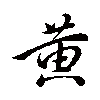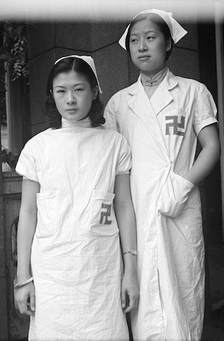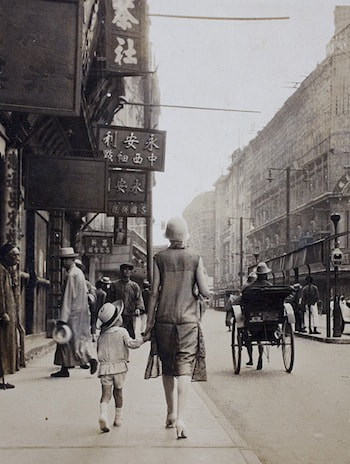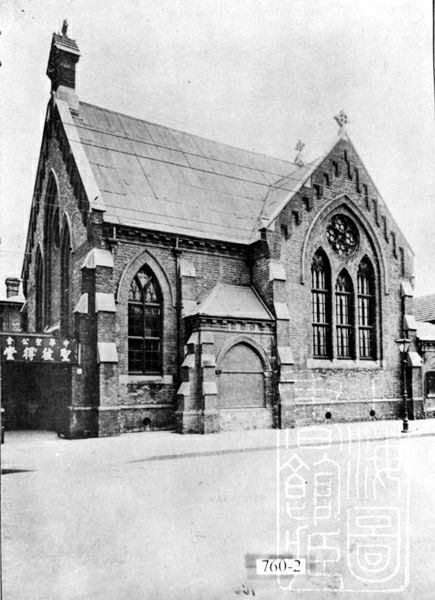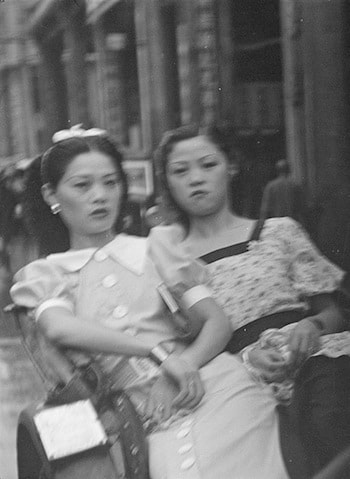Room & Board
c. 1926-1933
Assuming Zing Wei graduated from Tsunghua at the age of eighteen in about 1926, if she didn't leave earlier than that, she probably spent six or more years as a young unmarried woman in the center of the great city of Shanghai. Her barebones narrative offers no clues as to how her years in an American Christian enclave within this cosmopolitan world may have transformed her. Yet it is not too difficult to make a number of reasonable projections.
|
In her 1986 narrative, Zing Wei notes that she underwent four years of nursing training. In her 1991 letter she regrets her lack of “higher education”, but no matter how vocational, her course of study would have been not insubstantial. Nursing courses of the time are known to have involved the study of translated US nursing textbooks and instruction in hygiene, anatomy, physiology, obstetrics, gynecology, infectious diseases, childcare and the ethics of nursing. We know that by the time she joined St. Elizabeth’s, its nursing school had been running for over a decade – one of about eighty such programs and probably among the more well regarded. |
|
Given Tsunghua's Chinese leadership and staff, St. Elizabeth’s was most likely Zing Wei's first close encounter with the Western world and with Christianity. Suzhou had a foreign community, but much like Han Liang at a younger age in Amoy, we guess that Zing Wei would at best have espied it at a distance. While Zing Wei’s training would not pave the way for her to study in the US, it must have paralleled Han Liang's experience at the Anglo-Chinese College in Fuzhou in some ways. She most likely lived in a hospital dormitory with a small cohort of Chinese nurses under the supervision of the American nurses and doctors. At least some if not all the doctors were female. From these American trailblazers, who were themselves far from home, beyond the formal course of study, she would have been introduced to the English language and American ideas, values and practices – perhaps even her sometime-used English name of "Grace". At the same time, with labor unrest and anti-foreign feeling sharpening in the mid-1920s, it's possible that Zing Wei and her colleagues may also have received pressure to join in anti-foreign protests at the hospital or elsewhere, although nothing specific is known about whether or not there were such movements at St. Elizabeth's. |
|
It seems likely that a periodic interest in joining Christian activities must also date from this time. While the American staff may have been influential, even more important might have been the Chinese church community of the hospital's closely affiliated St. Peter's Church (聖彼得堂 Sheng Bide Tang). The church was located adjacent to the hospital compound and its 1898 building was in fact older than that of the hospital. In 1914, its tight-knit congregation of mainly intellectuals and businesspeople spun off from the American Episcopal Church and became self-supporting.
The church-hospital grounds in Sinza (新閘 Xinzha) were just south of Soochow Creek and the industrial Chapei district. In 1932, when the Japanese bombed Shanghai, Chapei was the first area hit and two other major churches of the diocese were flattened: a St. Stephen's and one of two St. Paul's churches. Peter, Paul and Stephen would be the names of her first three sons. Several hundred Chinese flooded into St. Peter's seeking refuge, and the parishioners rallied to provide food, clothing and other care. It's not specifically known whether St. Elizabeth's staff, such as Zing Wei, helped out. But it seems highly likely given that the hospital was so close to the bombing, and in light of the fact that it's known hospital staff did help out five years later when the Japanese launched a full-fledged invasion. Zing Wei's time at Tsunghua would probably have already rubbed out any distinctive village accent or vocabulary. Her way of speaking no doubt further evolved during these years, making her sound "authentically" Shanghainese in a way that her future husband never could. |
We know of no particular friendships sustained after Zing Wei left St. Elizabeth's, but conjecture that on Sundays after attending a service at St. Peter's, she and some of her fellow nurses might have stepped out to soak up what Shanghai had to offer. At no expense, they could have gazed on brightly lit store windows offering the latest fashions and a bustling parade of humanity from every quarter and every land. For a modest outlay, they would have had access to amusement parks and entertainment halls, a plethora of women’s magazines – many published by the Commercial Press, and an endless stream of movies produced both locally and in Hollywood. If not too closely monitored by their superiors at St. Elizabeth's, the young women may also have made the acquaintance of male members of the church or other gentlemen friends.
We will never know the exact balance of free will or necessity involved in Zing Wei's move to Shanghai or in the daily round of her life there, nor how ample or scant her free time, earnings or further prospects. But whether delighted or lonely, or a bit of both, we know that at least in retrospect, she took a measure of satisfaction in autonomously supporting herself. Later on Zing Wei did not talk to her children about her nursing career, but her daughter Helen recalls her mother supporting her aspiration to study medicine, if for no other reason than because she believed that a woman should always have something of her own to fall back on.
SOURCES
|
|
